The Universal name resonates with many of us as one of the best sailboat engines available. Despite Universal Motor Corp. no longer being in business, I plan to work on many more Universal engines in my time as a marine mechanic. Aboard my own boat, my little Universal M-series diesel has 8,000+ hours on it and it doesn’t (and probably won’t!) skip a beat. Yes, every small recreational diesel will have its flaws and quirks, but they all have one thing in common: they will keep going as long as we take care of them!
THE UNIVERSAL STORY
Last month you read about how Yanmar dominates the marine diesel engine market, operating on an excellent platform built over the last 100 years. Yanmar offers marine engines large and small. In terms of units in service and historical lineage, Universal Motor Corporation is a close runner up.
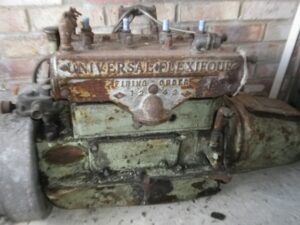
Universal Motor Corporation, originally headquartered in Oshkosh, WI, was at one time the largest producer of marine engines. The company began with the production of both loved (and hated!) gasoline Atomic 4. The Atomic 4 is actually a descendant of the “Utility 4”, which was built by Universal for the U.S. Navy during World War 2 as a lifeboat engine. In 1947, the new design for the Atomic 4 was put into production for use as a sailboat auxiliary.
This engine is a simple flathead 4-cylinder engine that is raw-water cooled. During its production run from 1947 to 1984, approximately 40,000 of these little 18-hp. engines were built, and today it’s estimated about 20,000 are still in use! In the early 1970s, Yanmar was becoming increasingly popular with its a line of small diesel auxiliaries, forcing Universal to come up with a new game plan to compete. Diesel engines were already becoming more popular due to their reliability, ability to do heavy work, and more importantly – posing less risk of explosion from highly volatile gasoline fuel vapors.

By 1976, Universal introduced a marinized Kubota (tractor) diesel engine, as the gasoline-powered Atomic 4 was quickly losing market share. You will still see several Atomic 4s in use today, however, as they still have quite a following and better support for parts/rebuild than you might expect, given their age. A great resource for these engines is Moyer Marine, a business on the east coast dedicated to offering support, parts and service for those of you who want to keep your little gasoline flathead 4 alive!
Many recreational boaters first became acquainted with the Universal name when they encountered the more desirable M-series diesel engines– myself included! In fact, if you look back to the 80s and the heyday of production boat building, Universal diesel engines had 42% of the market share, right behind Yanmar with 45%, followed by Volvo/Westerbeke/Perkins, which together held down the remaining 18%. Remarkably, many of of these vessels are still on the water , and the Universal M-series keeps on chugging.
THE ART OF MARINIZING
In 1976-1977, Universal switched gears to the diesel market and became what we now know as a marinizing company, as opposed to Yanmar, which builds complete engines with all-Yanmar parts. Instead, Universal acquired Kubota tractor engine blocks and contracted with various companies to build the marinized components, which together make up what we know today as the Universal Diesel. Universal would eventually be acquired by Westerbeke (in 1990) and Universal engines took another turn, but we’ll cover that more in depth down the road.
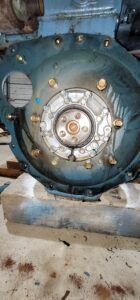
Universal’s diesel M-series are built to be simple, efficient, reliable, and easy to maintain. Kubota, a Japanese company that began business as a foundry, now builds engines for use in a variety of applications, specifically agricultural. However, they have more recently contracted to build and sell their engines to a variety of different companies for many different applications, including marine. Kubota saved the day for Universal by jumping in to provide an engine block that could fill the bill so Universal could continue to compete in the recreational marine engine game! This master plan worked, for a time, as Universal became Yanmar’s direct competitor for the world’s most popular production sailboats like Catalina, Pearson, C&C, and many more.
UNIVERSAL TRUTHS
Now, every engine and marinizing company has its flaws, and Universal has its own issues, as I have learned by working on hundreds of these little engines. As mentioned, Universal’s earlier diesels, while “marinized” to some degree. were built from engines that were never really intended for use in a marine environment. In my previous article from February, I wrote about how Yanmar builds everything from their engine blocks to the peripheral components with higher quality materials designed to
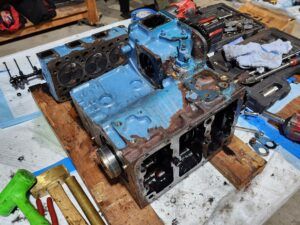
withstand the abuses found in a marine environment. Universal uses automotive-grade components for things like starters and alternators, and cheaper materials when it comes to things like heat exchangers. While this is nice for finding aftermarket (and cheap) components, that’s not always a plus if you have to replace them every few years because they can’t handle a damp salty environment.
When Westerbeke purchased Universal in 1990, along with the rights to their complete M-series engine line, a lot changed for the consumer and the mechanics working on the engines. Universal customers could no longer go to a Kubota dealer for parts, and since the newer engines are purpose built by Kubota for Universal/Westerbeke, there is no aftermarket for anything built after Westerbeke’s acquisition. This directs all purchasing for parts of new and old engines to Westerbeke and Westerbeke only. Where I really saw the change was when Kubota dealers would no longer help me when the price for a can of Universal Blue spray paint went to $96. They used to! I just bought a can of genuine, high-quality Yanmar gray spray paint (probably the best hard engine enamel I have ever used for a marine setting), and the can only cost me $17!

Don’t get me wrong, Universal M-series has a lot of great features I enjoy, both as a mechanic and an owner of a Universal M-25. Kubota has been building engines for a long time and they know what they are doing. Kubota engines are incredibly reliable and very resilient to neglect. While their older models aren’t the most efficient compared to their newer peers, they do tend to keep up when it comes to wear and tear if properly maintained.
As with any engine, internal premature wear and failure are usually the result of poor maintenance or operating errors. Still, the neglected engines I have seen are impressive in their ability to continue to run despite some serious damage. Since earlier Universals were built from Kubota’s line of existing tractor engines, it means there is a healthy aftermarket for affordable (not marine priced!) parts, including complete overhaul kits that make it possible for me to rebuild these engines for my customers instead of forcing them to buy a whole new engine because something small has failed. The Kubota engines used for this older small-engine line are designed to be rebuildable, not disposable.
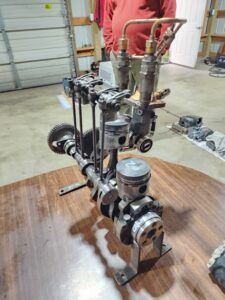
Here are some examples: These engine blocks have removable dry cylinder liners that take the expense/difficulty of heavy-cylinder machining out of the picture and really help folks who are in locations that may rely on being able to rebuild these engines without any crazy tools. The mechanical unit injectors and injection pump are common and identical in most of the M-series line, and even in other model Kubota engines, making replacement/rebuild pretty easy. Thanks to a remote heat exchanger, if it ever fails, and that exact part isn’t available, you have the ability to plumb in a different model if you have to.
The exhaust elbow of the Kubota-block Universal is one of my favorites. It’s nothing more than 1-1/4 in. NPT threaded pipe you can build to fit your boat’s engine space. A piece of 316-series stainless pipe is very affordable. In a pinch, you can rebuild it with parts from a local hardware store. The engine has a lower compression ratio, making glowplugs necessary, but as long as they are working well, the engine will start fairly easily every time. In an era where engines are considered “disposable”, this is a big deal for those of us who want to keep our little engines happy for years to come!
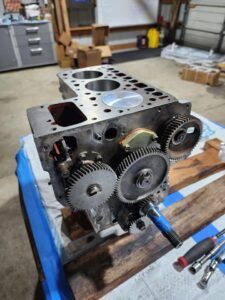
As time moves goes on, I have faith that I will continue to rebuild the original M-series Universal diesels, as they are designed to be repaired with bailing wire and twine, just as farmers do it in the field,. Tough little engines you can rebuild anywhere from shade-tree parts: Maybe that’s Universal’s real legacy.





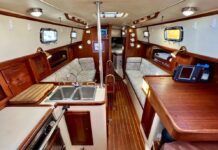


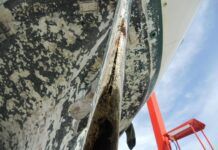
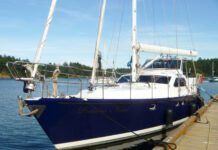

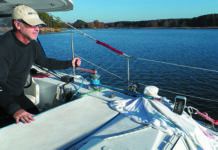
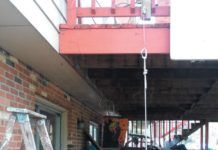











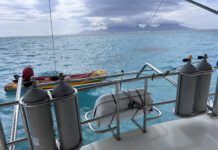


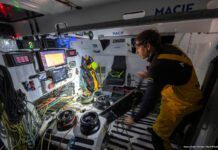


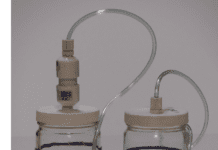
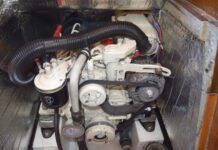





I’m in the process of rebuilding my 1982 M-30. Other than cleaning the injectors and rebuilding the water pump, the engine was in great shape – with all 3 cylinders having 520# compression. Looking forward to another 40 years out of the rebuild!
Thank you for the history lesson Meredith. Although I have a Beta Marine, it too is built around a dependable Kubota block. For those of us that enjoy (mostly) the pleasure of maintaining our own boat and various systems, simple and reliable are the features we most value.
I think I’ll change my oil tomorrow.